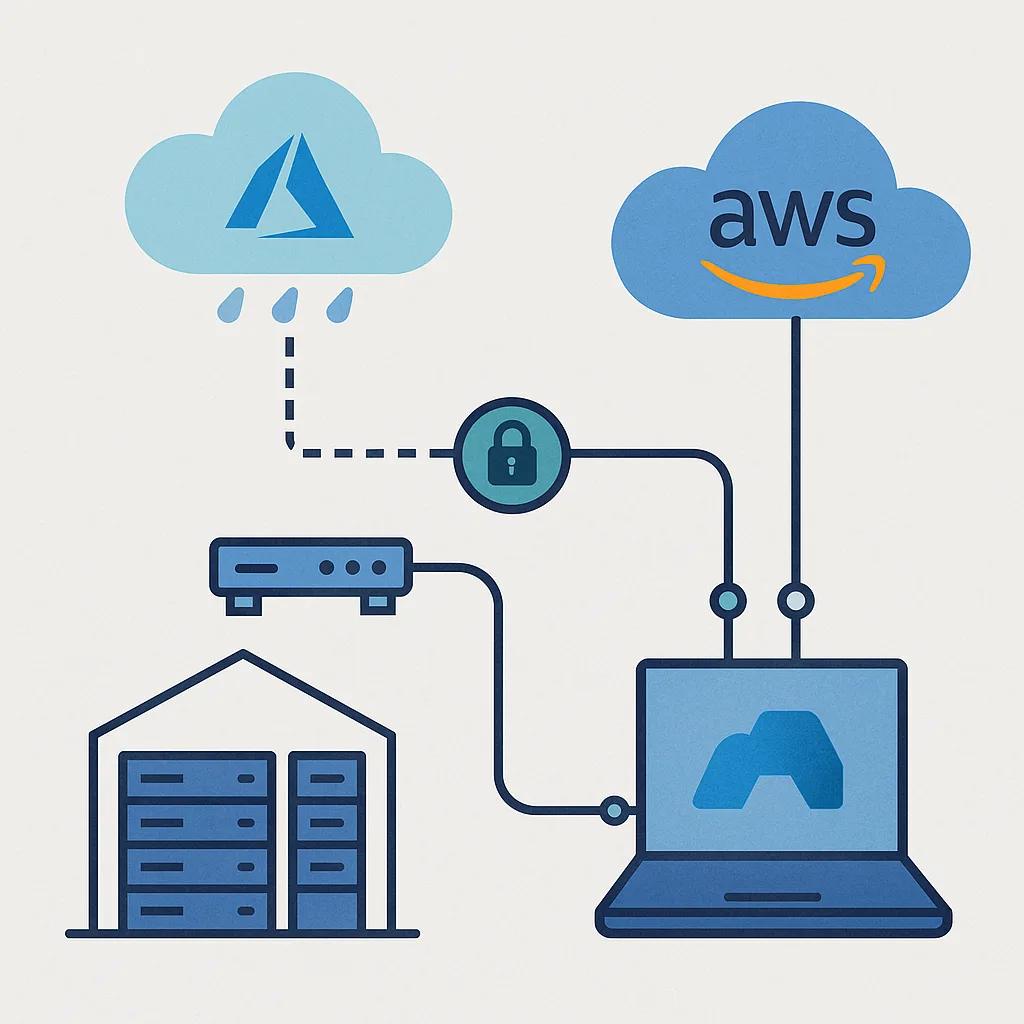As enterprises embrace hybrid cloud architectures, securely connecting on-premises infrastructure to cloud environments like Azure and AWS has become mission-critical. Whether you’re migrating workloads, enabling cloud bursting, or ensuring high availability, the link between your datacenter and the cloud must be fast, secure, and reliable.
In this guide, we break down the best practices, architectural options, and key technologies—like Site-to-Site VPN, Azure ExpressRoute, and AWS Direct Connect—for building robust and secure hybrid cloud connectivity.
Why Hybrid Cloud Connectivity Matters
Without secure and efficient connectivity:
- Applications may experience high latency or downtime
- Data transfers could be intercepted or throttled
- Failover and disaster recovery may be compromised
- Compliance mandates for data residency or encryption could be violated
Hybrid connectivity is not just about performance—it’s about security, control, and continuity.
Core Connection Methods: Overview
| Method | Description | Use Case |
|---|---|---|
| Site-to-Site VPN | Encrypted IPsec tunnel over the public internet | Quick setup, lower cost |
| Direct Connect (AWS) / ExpressRoute (Azure) | Dedicated private link from on-prem to cloud | High-performance, stable connection for enterprise workloads |
Site-to-Site VPN: Encrypted and Flexible
How It Works:
- Uses IPsec tunnels to connect on-prem firewalls or routers to cloud virtual gateways
- AES encryption, SHA hashing, and IKEv2 protocols used for secure transport
- Supported by most enterprise-grade firewalls and SD-WAN platforms
Best Practices:
- Use redundant VPN tunnels for failover
- Enforce strong encryption and PFS (Perfect Forward Secrecy)
- Configure BGP routing for dynamic failover (optional)
- Monitor VPN uptime and performance with SNMP or API polling
- Restrict tunnel access to required subnets only
Use When:
- You need rapid deployment
- Bandwidth demands are moderate
- You’re bridging temporary environments or performing initial migrations
AWS Direct Connect: Private High-Speed Access
What It Is:
- A dedicated physical connection between your datacenter and an AWS location
- Supports speeds from 50 Mbps up to 100 Gbps
- Traffic bypasses the public internet for predictable latency and enhanced security
Key Features:
- 802.1q VLAN tagging
- Supports private VIFs (to VPCs) and public VIFs (to AWS services)
- Can be integrated with VPN as backup (hybrid model)
Security Tips:
- Use MACSec (Media Access Control Security) if supported for Layer 2 encryption
- Limit BGP advertisements to required prefixes
- Monitor link performance with CloudWatch and SNMP traps
Azure ExpressRoute: Enterprise-Class Cloud Peering
What It Is:
- Azure’s answer to Direct Connect
- Establishes private peering between on-prem and Azure via an ExpressRoute circuit
- Integrates with Microsoft services and global Azure regions
Benefits:
- No public IPs needed for private routing
- Dual circuits for high availability
- Option for ExpressRoute Global Reach for connecting remote sites via Azure backbone
Security Configuration:
- Use Network Security Groups (NSGs) to filter ExpressRoute traffic
- Deploy firewalls or NVAs at the cloud edge for inspection
- Apply role-based access controls (RBAC) to ExpressRoute resources
Building a Secure Hybrid Cloud Topology
Recommended Architecture:
- Dual-path design: Primary via Direct Connect/ExpressRoute, Backup via VPN
- Use BGP routing with AS-path prepend or metrics to prioritize routes
- Route only necessary subnets across the link
- Insert a cloud firewall or NVA (Network Virtual Appliance) between the edge and VNet/VPC
High Availability:
- Use two physical circuits from different providers/data centers
- Terminate into multiple cloud regions if required for resilience
- Enable automatic route failover
Key Security Best Practices
- Encrypt all tunnels (even over private circuits if sensitive data is involved)
- Use firewalls and NSGs/NACLs to restrict traffic paths
- Enable logging and flow monitoring (Azure Network Watcher, VPC Flow Logs)
- Perform regular key rotation for VPN pre-shared keys
- Validate cloud and on-prem routing tables for unintended overlaps
- Implement segmentation using VLANs or cloud subnets to isolate traffic types
Compliance Considerations
- Ensure the connectivity architecture meets standards like:
- ISO 27001
- PCI-DSS
- GDPR / Data Sovereignty Rules
- Leverage Private Link (Azure) or VPC Endpoints (AWS) to avoid public traffic for PaaS services
Tools and Monitoring Options
- Azure Monitor + Network Watcher
- AWS CloudWatch + Direct Connect metrics
- SNMP from your on-prem router or firewall
- Cloud-native logging (Flow Logs, NSG/ACL logging)
Use these tools to detect:
- Latency spikes
- Tunnel flaps or drops
- Unauthorized traffic flows
- Unexpected BGP advertisements
Conclusion
Secure cloud connectivity isn’t just about plugging in a VPN tunnel—it’s about designing for resilience, speed, visibility, and least privilege access. Whether you’re using VPN, Direct Connect, or ExpressRoute, your hybrid architecture should be built for scale, compliance, and zero-trust principles.
Done right, secure cloud connections enable seamless application migration, faster innovation, and bulletproof disaster recovery.


